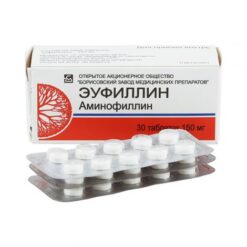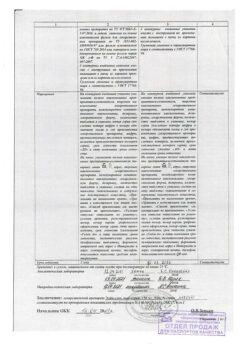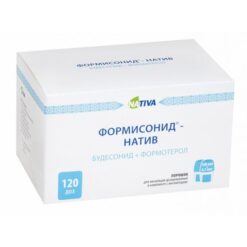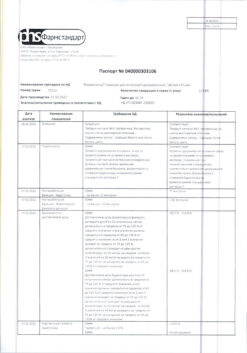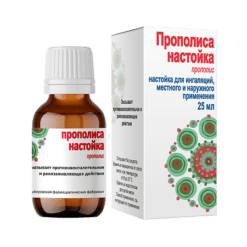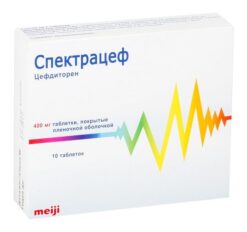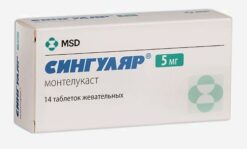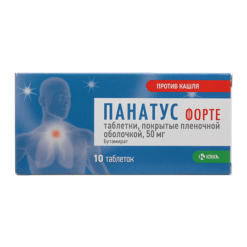No products in the cart.
Berotek N, aerosol 100 mcg/dose 200 doses
€16.62 €13.85
Description
Berotec N is a bronchodilator.
Preferentially stimulates beta2-adrenoreceptors. It relaxes the smooth muscles of the bronchi and blood vessels and counteracts the development of bronchospastic reactions caused by histamine, methacholine, cold air and allergens (immediate-type hypersensitivity reactions). Immediately after prescription, fenoterol blocks the release of mediators of inflammation and bronchoobstruction from mast cells. In addition, when using fenoterol in higher doses, increased mucociliary clearance has been noted.
The beta-adrenergic effects of the drug on cardiac activity (increased strength and HR) are due to the vascular action of fenoterol, the stimulation of beta2 adrenoreceptors of the heart, and when using doses higher than the therapeutic doses, stimulation of beta1 adrenoreceptors. Tremor is the most common undesirable effect when using beta-agonists.
The drug reduces myometrial contractile activity and tone.
Pharmacodynamics
Phenoterol prevents and quickly stops bronchospasm of various genesis. Onset of action after inhalation – 5 minutes, maximum – 30-90 minutes, duration – 3-6 hours.
Pharmacokinetics
. Depending on the inhalation method and the inhalation system used, about 10-30% of the active ingredient released from the aerosol product after inhalation reaches the lower airways, and the rest is deposited in the upper airways and swallowed. As a result, some amount of inhaled fenoterol enters the GI tract. After inhalation of 1 dose of the drug, the degree of absorption is 17% of the administered dose. Absorption is biphasic – 30% of phenoterol hydrobromide is quickly absorbed with T1/2 11 min, and 70% is slowly absorbed with T1/2 120 min.
After oral administration, approximately 60% of phenoterol hydrobromide is absorbed. Time to reach plasma Cmax is 2 hours. Binding to plasma proteins is 40-55%. Metabolized in the liver. It is excreted by kidneys and with bile as inactive sulphate conjugates.
In parenteral administration, fenoterol hydrobromide is excreted according to a three-phase model with T1/2 of 0.42 min, 14.3 min and 3.2 h. Biotransformation of fenoterol hydrobromide in humans proceeds exclusively by conjugation with sulfates primarily in the intestinal wall.
Phenoterol hydrobromide may pass unchanged through the placental barrier and into the breast milk.
Indications
Indications
Prevention and relief of bronchospasm in bronchial asthma, chronic obstructive bronchitis, emphysema.
Prevention of asthma by physical effort.
Symptomatic treatment of bronchial asthma and chronic obstructive pulmonary disease.
Pharmacological effect
Pharmacological effect
Berotek N is a bronchodilator.
Selectively stimulates beta2-adrenergic receptors. Relaxes the smooth muscles of the bronchi and blood vessels and counteracts the development of bronchospastic reactions caused by the influence of histamine, methacholine, cold air and allergens (immediate hypersensitivity reactions). Immediately after administration, fenoterol blocks the release of mediators of inflammation and bronchial obstruction from mast cells. In addition, when using fenoterol in higher doses, increased mucociliary clearance was noted.
The beta-adrenergic effect of the drug on cardiac activity (increased strength and heart rate) is due to the vascular effect of fenoterol, stimulation of beta2-adrenergic receptors of the heart, and when using doses exceeding therapeutic ones, stimulation of beta1-adrenergic receptors. Tremor is the most common adverse effect with beta-agonists.
The drug reduces contractile activity and myometrial tone.
Pharmacodynamics
Fenoterol prevents and quickly relieves bronchospasm of various origins. The onset of action after inhalation is 5 minutes, maximum is 30–90 minutes, duration is 3–6 hours.
Pharmacokinetics
Depending on the method of inhalation and the inhalation system used, about 10–30% of the active substance released from the aerosol preparation after inhalation reaches the lower respiratory tract, and the rest is deposited in the upper respiratory tract and swallowed. As a result, some amount of inhaled fenoterol enters the gastrointestinal tract. After inhalation of 1 dose of the drug, the degree of absorption is 17% of the administered dose. Absorption is biphasic – 30% of fenoterol hydrobromide is rapidly absorbed with a T1/2 of 11 minutes, and 70% is absorbed slowly with a T1/2 of 120 minutes.
After oral administration, about 60% of fenoterol hydrobromide is absorbed. The time to reach Cmax in blood plasma is 2 hours. Plasma protein binding is 40–55%. Metabolized in the liver. It is excreted by the kidneys and bile in the form of inactive sulfate conjugates.
When administered parenterally, fenoterol hydrobromide is excreted according to a three-phase model with T1/2 – 0.42 min, 14.3 min and 3.2 hours. The biotransformation of fenoterol hydrobromide in humans occurs exclusively through conjugation with sulfates, mainly in the intestinal wall.
Fenoterol hydrobromide can pass unchanged through the placental barrier and enter breast milk.
Special instructions
Special instructions
When using Berotec® N metered-dose aerosol for the first time, patients may notice that the new aerosol has a slightly different taste compared to the previous aerosol containing freon. Patients should be warned about this when switching from Berotek® N, which contains freon, to Berotek® N, which does not contain freon. Patients need to know that Berotek®N, containing freon, and Berotek®N, which does not contain freon, are completely interchangeable, and changes in taste do not affect the effectiveness and safety of the drug.
Other sympathomimetic bronchodilators can be used together with Berotec®N only under medical supervision. If you experience acute, rapidly worsening shortness of breath (difficulty breathing), consult a doctor immediately.
Long-term use:
Relief of bronchial asthma attacks may be preferable to regular use of the drug (symptomatic treatment).
Patients should be examined to determine the need for additional or more intensive anti-inflammatory treatment (for example, inhaled corticosteroids) in order to control airway inflammation and prevent long-term exacerbations of bronchial asthma.
In the case of increased bronchial obstruction, it is considered unacceptable and may even be risky to increase the frequency of dosing of β2-adrenergic receptor agonists contained in drugs such as Berotec® N dosed inhalation aerosol beyond the recommended doses. In such a situation, the treatment plan and, especially, the adequacy of anti-inflammatory therapy should be reconsidered.
When treated with β2-adrenergic receptor agonists, severe hypokalemia may develop. Particular caution should be exercised in severe bronchial asthma, as this effect can be enhanced by the concomitant use of xanthine derivatives, corticosteroids and diuretics. With hypoxia, the effect of hypokalemia on heart rate may increase. In such situations, regular monitoring of serum potassium concentration is recommended.
In rare cases, myocardial ischemia associated with β2-adrenergic agonists has been observed.
Hypokalemia in patients receiving digoxin increases sensitivity to cardiac glycosides and may cause arrhythmia.
Impact on the ability to drive vehicles and operate machinery
The effect of the drug on the patient’s ability to perform work that requires increased attention and speed of psychomotor reactions has not been established.
Active ingredient
Active ingredient
Fenoterol
Composition
Composition
Active ingredient:
fenoterol hydrobromide – 100 mcg.
Excipients:
anhydrous citric acid – 0.001 mg,
absolute ethanol – 15.597 mg,
purified water – 1.04 mg,
1,1,1,2-tetrafluoroethane (HFA 134a, propellant) – 35.252 mg.
Contraindications
Contraindications
Hypersensitivity, hypertrophic obstructive cardiomyopathy, tachyarrhythmias, heart disease, aortic stenosis, decompensated diabetes mellitus, thyrotoxicosis, glaucoma, threatened abortion, pregnancy (first trimester).
Side Effects
Side Effects
From the immune system: hypersensitivity.
Metabolism: hypokalemia.
From the nervous system: excitement, nervousness, tremor, headache, dizziness.
From the cardiovascular system: myocardial ischemia, arrhythmia, tachycardia, palpitations, increased systolic blood pressure, decreased diastolic blood pressure.
From the respiratory system: paradoxical bronchospasm, irritation of the larynx and pharynx.
From the digestive system: nausea, vomiting.
From the skin and subcutaneous tissues: hyperhidrosis, skin reactions such as rash, itching, urticaria.
From the musculoskeletal system: muscle spasm, myalgia, muscle weakness.
Interaction
Interaction
Beta-adrenergic agonists and anticholinergics, xanthine derivatives (including theophylline), cromoglycic acid, corticosteroids and diuretics may enhance the effect and side effects of fenoterol. A significant weakening of the bronchodilator effect of fenoterol is possible with simultaneous use of beta-blockers.
Berotec® N should be prescribed with caution to patients receiving MAO inhibitors and tricyclic antidepressants, because these drugs can enhance the effect of fenoterol.
Inhalation anesthetics containing halogenated hydrocarbons (including halothane, trichlorethylene, enflurane) can enhance the effect of fenoterol on the cardiovascular system (possible development of arrhythmias). The simultaneous administration of bronchodilators with a similar mechanism of action leads to an additive effect and overdose phenomena.
Overdose
Overdose
Symptoms: tachycardia, increased heart rate, tremor, decreased/increased blood pressure, increased pulse pressure, anginal pain, arrhythmias and facial flushing.
Treatment: prescription of sedatives, tranquilizers; in severe cases, intensive symptomatic therapy is indicated. The use of beta-blockers (preferably selective beta1-blockers) is recommended as specific antidotes. However, it is necessary to take into account the possibility of increased bronchial obstruction and carefully select the dose of these drugs in patients with bronchial asthma.
Storage conditions
Storage conditions
At a temperature not exceeding 25 °C
Shelf life
Shelf life
3 years
Manufacturer
Manufacturer
Boehringer Ingelheim Pharma GmbH & Co.KG, Germany
Additional information
| Shelf life | 3 years |
|---|---|
| Conditions of storage | At a temperature not exceeding 25 °C |
| Manufacturer | Boehringer Ingelheim Pharma GmbH & Co. |
| Medication form | inhalation aerosol |
| Brand | #Н/Д |
Related products
Buy Berotek N, aerosol 100 mcg/dose 200 doses with delivery to USA, UK, Europe and over 120 other countries.



